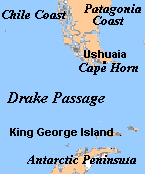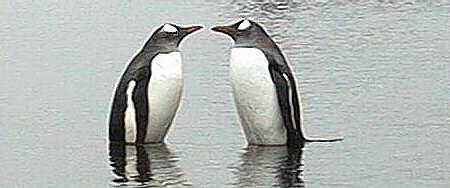 |
|
 click map for more detailed location info |

Gentoos
Report 15 February - Team B on board Pelagic at Dorian Cove
Mon 15th FebSpecial note:best wishes and warmth to Jeremy's colleagues at BUPA, he is working hard on bringing back a vision of antarctica for you.
One penguin, two penguins ..... 1242 penguins... on no, don't put me off, I'll lose count ..... 1843 penguins give or take a few. phew.
Yesterday afternoon, Nigel Milius, the wildlife researcher at Port Lockroy, Kirsten and Heather went out to count Gentoo penguin chicks on Wiencke Island. We covered an area of perhaps 2kms square, taking 4 hours to complete the count. Of course the opening sentence is misleading, we didn't count the chicks in one lot, rather Nigel divided the area into small sections for ease and greater accuracy. It was necessary to count the chicks in each section 3 times. If the numbers then weren't within 5- 10%, we had to do it again. So, in fact between us we counted over 5,500 chicks. An apparently easy task, it took a little getting used to.
We had to go carefully. The penguins here are not used to humans and to walk too close causes a flurry of feathers and mini stampede. Kirsten got dizzy and very sleepy after one hour counting .It is like counting sheep...she laid down on one of the huge rocks on the beach for a pause and fell asleep, finding the work finished when she woke up!
The gentoos start to breed from the end of october, the timing is dependant on the speed at which the sea ice and snow cover recedes. They build their nests on snow free rock which means most of the chicks were to be found on higher ground. We marvelled at the agility, albeit inelegant, of these birds hopping up and down the craggy rocks which we could only climb with good hiking boots. At this location the first eggs are laid in early November. Therefore, with an incubation period of 5 weeks, the first chicks appear mid December. Once the egg is laid, the male and female take turns to protect it and subsequently the chick, while the other forages for food - a real team effort.
This season, Nigel has observed a decrease in breeding success in the areas of his study, of less than 1 egg (0.7) per breeding pair. He thinks this is due to lack of food, mainly krill, early in the season. Adults spend up to 6 days away at a time looking for food. Eventually the remaining adult becomes disinterested in the chick, leaving the way open for predators such as skuas and sheathbills to snatch the young. Engrossed in the count, we were suddenly startled when a benign rock shifted then roared menacingly.
It was a slumbering fur seal awoken from its afternoon nap. We quickly moved away. Fur seals have been known to take lumps out of people. In fact today we almost lost our team coordinator Adrian. A fur seal saw him as a nice starter for lunch and tried to get him. Fortunately Adrian managed to jump away from him. His simple conclusion:'these seals have an attitude problem'.
Because of bad weather (snow, northern wind) we stayed for the rest of the day in Dorian Cove. We visited the Australian geologist Trevor Robertson on his boat Iron Bark 2 (12 metres). We met him last week at Vernadsky Station. There he told us about his plans to over winter in the Antarctic this coming winter season.
We took a look at the interior of the boat where he will live in the coming 8 months, all alone, stuck in the ice. He will be the third man in history - if he manages it - to over winter here in a small yacht. The Iron Bark is a well built and very efficiently organised boat, however it has a very cold interior: Not one picture on the wall, nothing cosy,just a totally utilitarian cabin. We realise now more than ever that the Pelagic is a superluxury yacht.
Trevor is a man who has travelled around the world a lot, both as a sailor and as an employee of oil companies,working on oilrigs. He has loads of interesting stories to tell and is not an introvert person at all.laughing and joking, he gets on with everyone very well. Still he chooses to be alone the whole long Antarctic winter in his barely heated boat (he keeps it warm up to 1 degree celsius, that is warm enough for him he says and it saves energy).
He has no means of communication with him, so when he gets ill for example, he has to solve the problem himself. 'Nobody asked me to come here, I don't want to bother people of the scientific bases with my problems'. He thinks he has enough food and energy to survive the winter. He also took enough medicine to help him out in case of any illness. But he would like to have more local anaesthetics in case he has to amputate some parts of his body.
Yes, you also have to think of all the horrible things that might happen whilst staying here in total isolation. To the question why, trevor has a simple answer:'if you have to ask why,you shouldn't be here. It is a feeling that you have to come, which is difficult to explain to many people. I just want to see what it is like. I think it is very interesting. That's it'. We hope to contact him next summer to hear about his experiences.
The coming week we will have to get used to the idea of going back home again, to the Netherlands, Scotland, England, America. It is rather difficult to imagine yourself living in a house again, going to work and so on. Tomorrow we hope to sail up north to the Melchior Islands. There we will wait for the right moment (preferably southern wind, no storm) to sail back to Ushuaia and the rest of the world via the Drake Passage. This time hopefully without a seasick crew.
Kirsten Kuipers
| Weather and Position Data | |||
| 1. Date | 2. Time | 3. Posn Lat | 4. Posn Long |
| 15/02 | 11.44 local | 64°-48.99S | 63°-30.03W |
| 5. Compass Heading | 6. Wind Speed | 7. Boat speed | 8. Wind Dir |
| 67° | 10 Knots | 0 Knots | -100° |
| 9. Pressure | 10. Air Temp | 11. Sea Temp | 12. Cloud Type |
| 992 | +1°C | no data | cumulus |
| 13. Cloud cover | 14. Precipitation | 15. Sea State | 16.Comments |
| 100% | light snow | anchored | Dorian cove windchill -10 |